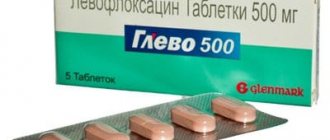Levofloxacin
Fluoroquinolone, a broad-spectrum antimicrobial bactericidal agent. Blocks DNA gyrase (topoisomerase II) and topoisomerase IV, disrupts supercoiling and cross-linking of DNA breaks, suppresses DNA synthesis, causes profound morphological changes in the cytoplasm, cell wall and membranes of bacteria.
Levofloxacin is active in vivo and in vitro against the following microorganisms:
Aerobic gram-positive microorganisms: Corynebacterium diphtheriae, Enterococcus spp. (including Enterococcus faecalis), Listeria monocytogenes, Staphylococcus spp. (leukotoxin-containing and coagulase-negative methicillin-sensitive/moderately sensitive strains), including Staphylococcus aureus (methicillin-sensitive strains), Staphylococcus epidermidis (methicillin-sensitive strains); Streptococcus spp. groups C and G, Staphylococcus agalactiae, Streptococcus pneumoniae (penicillin-sensitive/moderately sensitive/resistant strains), Streptococcus pyogenes, Streptococcus spp. viridans group (penicillin-sensitive/resistant strains).
Aerobic gram-negative microorganisms: Acinetobacter spp. (including Acinetobacter baumannii), Actinobacillus actinomycetemcomitans, Citrobacter freundii, Eikenella corrodens, Enterobacter spp. (including Enterobacter aerogenes, Enterobacter agglomerans, Enterobacter cloacae), Escherichia coli, Gardnerella vaginalis, Haemophilus ducreyi, Haemophilus influenzae (ampicillin-sensitive/resistant strains), Haemophilus parainfluenzae, Helicobacter pylori, Klebsiella spp. (including Klebsiella oxytoca, Klebsiella pneumoniae), Moraxella catarrhalis (beta-lactamase producing and non-producing strains), Morganella morganii, Neisseria gonorrhoeae (penicillinase producing and non-producing strains), Neisseria meningitidis, Pasteurella spp. (including Pasteurella canis, Pasteurella dagmatis, Pasteurella multocida), Proteus mirabilis, Proteus vulgaris, Providencia spp. (including Providencia rettgeri, Providencia stuartii), Pseudomonas spp. (including Pseudomonas aeruginosa), Serratia spp. (including Serratia marcescens), Salmonella spp.
Anaerobic microorganisms: Bacteroides fragilis, Bifidobacterium spp., Clostridium perfringens, Fusobacterium spp., Peptostreptococcus spp., Propionibacterium spp., Veillonella spp.
Other microorganisms: Bartonella spp., Chlamydia pneumoniae, Chlamydia psittaci, Chlamydia trachomatis, Legionella pneumophila, Mycobacterium spp. (including Mycobacterium leprae, Mycobacterium tuberculosis), Mycoplasma hominis, Mycoplasma pneumoniae, Rickettsia spp., Ureaplasma urealyticum.
Moderately
sensitive microorganisms (minimum inhibitory concentration more than 4 mg/ml):
Aerobic gram-positive microorganisms: Corynebacterium urealyticum, Corynebacterium xerosis, Enterococcus faecium, Staphylococcus - epidermis (methicillin-resistant strains), Staphylococcus haemolyticus (methicillin-resistant strains).
Aerobic gram-negative microorganisms: Burkholderia cepacia, Campylobacter jejuni, Campilobacter coli.
Anaerobic microorganisms: Bacteroides thetaiotaomicron, Bacteroides vulgates, Bacteroides ovatus, Prevotella spp., Porphyromonas spp.
Resistant microorganisms (minimum inhibitory concentration greater than 8 mg/ml):
Aerobic gram-positive microorganisms: Corynebacterium jeikeium, Staphylococcus aureus (methicillin-resistant strains), other Staphylococcus spp. (coagulase-negative methicillin-resistant strains).
Aerobic gram-negative microorganisms: Alcaligenes xylosoxidans.
Other microorganisms: Mycobacterium avium.
Levofloxacin-VERTEX
Allergic reactions:
Sometimes: itching and redness of the skin.
Rare: general hypersensitivity reactions (anaphylactic and anaphylactoid reactions) with symptoms such as urticaria, bronchial constriction and possibly severe suffocation.
In very rare cases: swelling of the skin and mucous membranes (for example, in the face and throat), sudden drop in blood pressure and shock; increased sensitivity to solar and ultraviolet radiation (see “Special instructions”); allergic pneumonitis; vasculitis
In some cases: severe skin rashes with blistering, such as Stevens-Johnson syndrome, toxic epidermal necrolysis (Lyell's syndrome) and exudative erythema multiforme. General hypersensitivity reactions may sometimes be preceded by milder skin reactions. The above reactions can develop after the first dose, a few minutes or hours after administration of the drug. From the digestive system:
Common: nausea, diarrhea, increased activity of liver enzymes (eg, alanine aminotransferase and aspartate aminotransferase).
Sometimes: loss of appetite, vomiting, abdominal pain, digestive disorders.
Rare: diarrhea mixed with blood, which in very rare cases may be a sign of intestinal inflammation and even pseudomembranous colitis (see “Special Instructions”). From the side of metabolism:
Very rare: decreased blood glucose concentration, which is of particular importance for patients with diabetes; Possible signs of hypoglycemia: increased appetite, nervousness, perspiration, trembling. Experience with the use of other quinolones suggests that they can cause exacerbation of porphyria in patients already suffering from this disease. A similar effect cannot be excluded when using the drug levofloxacin. From the nervous system:
Sometimes: headache, dizziness and/or stupor, drowsiness, sleep disturbances.
Rarely: anxiety, paresthesia in the hands, trembling, psychotic reactions such as hallucinations and depression, agitation, convulsions and confusion.
Very rare: visual and hearing impairment, impaired taste and smell, decreased tactile sensitivity. From the cardiovascular system:
Rarely: increased heart rate, decreased blood pressure.
Very rare: (shock-like) vascular collapse.
In some cases: prolongation of the QT interval. From the musculoskeletal system:
Rarely: tendon lesions (including tendinitis), joint and muscle pain.
Very rare: tendon rupture (eg Achilles tendon); this side effect can be observed within 48 hours after the start of treatment and can be bilateral (see “Special Instructions”); muscle weakness, which is of particular importance for patients with bulbar syndrome.
In some cases: muscle damage (rhabdomyolysis). From the urinary system:
Rarely: increased levels of bilirubin and creatinine in the blood serum.
Very rare: deterioration of kidney function up to acute renal failure, interstitial nephritis. From the hematopoietic organs:
Sometimes: an increase in the number of eosinophils, a decrease in the number of leukocytes.
Rarely: neutropenia; thrombocytopenia, which may be accompanied by increased bleeding.
Very rare: agranulocytosis and the development of severe infections (persistent or recurrent increase in body temperature, deterioration of health).
In some cases: hemolytic anemia; pancytopenia. Other side effects:
Sometimes: general weakness.
Very rare: fever.
Any antibiotic therapy can cause changes in the microflora that is normally present in humans. For this reason, increased proliferation of bacteria and fungi resistant to the antibiotic used may occur, which in rare cases may require additional treatment.
Overdose
Symptoms of an overdose of Levofloxacin appear at the level of the central nervous system (confusion, dizziness, disturbances of consciousness and seizures of the epileptic type). In addition, gastrointestinal disorders (for example, nausea) and erosive lesions of the mucous membranes, prolongation of the QT interval may occur.
Treatment should be symptomatic. Levofloxacin is not eliminated by dialysis (hemodialysis, peritoneal dialysis and continuous peritoneal dialysis). There is no specific antidote.
Levofloxacin-Solopharm eye drops 0.5% 5ml
Pharmacodynamics
Levofloxacin is the L-isomer of the racemic drug substance ofloxacin.
The antibacterial activity of ofloxacin relates mainly to the L-isomer. As an antibacterial drug of the fluoroquinolone class, levofloxacin blocks DNA gyrase (topoisomerase II) and topoisomerase IV, disrupts supercoiling and cross-linking of DNA breaks (deoxyribonucleic acid), suppresses DNA synthesis, causes profound morphological changes in the cytoplasm, cell wall and membranes.
Mechanism of resistance development
Resistance to levofloxacin can develop primarily through two main mechanisms, namely: a decrease in the intracellular concentration of the drug or changes in the targets of the drug. Changes in the targets of the two bacterial enzymes DNA gyrase and topoisomerase IV are the result of mutations in the chromosomal genes encoding DNA gyrase ( gyrA
and
gyrB )
and topoisomerase IV
(pa r C
and
parE
,
grlA
and
grlB
in Staphylococcus aureus).
Drug resistance due to low intracellular concentration develops as a result of changes in the porin channel system of the outer cell membrane, which leads to a decrease in fluoroquinolone entry into gram-negative bacteria, or from efflux pumps. Efflux-mediated resistance has been described in pneumococci ( PmrA
), staphylococci
( NorA
), anaerobic and gram-negative bacteria.
Plasmid-mediated quinolone resistance (defined by the qnr )
has been found against Klebsiella pneumoniae and Escherichia coli. The development of cross-resistance between fluoroquinolones is possible. Single mutations may not lead to clinical resistance, but multiple mutations cause clinical resistance to all drugs in the fluoroquinolone class. Alterable outer membrane porins and efflux systems can have broad substrate specificity, affecting multiple classes of antibacterial agents and leading to multiple resistance.
Its effectiveness against gram-positive aerobes - Enterococcus faecalis - has been established in vitro and confirmed in clinical studies. Staphylococcus aureus (methicillin-sensitive strains), Staphylococcus epidermidis (methicillin-sensitive strains), Staphylococcus saprophyticus, Streptococcus pneumoniae (including multi-resistant strains - MDRSP), Streptococcus pyogenes, gram-negative aerobes - Enterobacter cloacae, Escherichia coli, Haemophilus influenzae, Haemophilus paraintluenzae , Klebsiella pneumoniae, Legionella pneumophila, Moraxella catarrhalis, Proteus mirabilis, Pseudomonas aeruginosa, Serratia marcescens and other microorganisms - Chlamydia pneumoniae, Mycoplasma pneumoniae. For the majority (90%) of strains of the following microorganisms, minimum inhibitory concentrations of levofloxacin (2 μg/ml or less) have been established in vitro, however, the effectiveness and safety of the clinical use of levofloxacin in the treatment of infections caused by these pathogens has not been established in adequate and well-controlled studies: gram-positive aerobes - Staphylococcus haemolyticus, Streptococcus (group C/F), Streptococcus (group G), Streptococcus agalactiae, Streptococcus milleri. Streptococcus viridans, gram-negative aerobes - Acinetobacter lwoffii, Acinetobacter baumannii, Bordetella pertussis, Citrobacter (diversus) koseri, Citrobacter freundii, Enterobacter aerogenes, Enterobacter sakazakii, Klebsiella oxytoca, Morganella morganii, Pantoea (Enterobacter) agglomerans, Proteus vulgaris, Providencia re ttgeri, Providencia stuartii , Pseudomonas fluorescens, gram-positive anaerobes - Clostridium perfringens.
Sensitive microorganisms: aerobic gram-positive microorganisms -
Corynebacterium diphtheriae, Enterococcus spp., including Enterococcus faecalis, Listeria monocytogenes, Staphylococcus spp.
(coagulase-negative methicillin-sensitive/leukotoxin-containing/moderately sensitive strains), including Staphylococcus aureus (methicillin-sensitive strains), Staphylococcus epidermidis (methicillin-sensitive strains), Streptococcus spp. groups C and G, Streptococcus agalactiae, Streptococcus pneumoniae (penicillin-sensitive/moderately sensitive/resistant strains), Streptococcus pyogenes, Streptococcus spp. viridans group (penicillin-sensitive/resistant strains), aerobic gram-negative microorganisms -
Acinetobacter spp., including Acinetobacter baumannii, Acinetobacillus actinomycetecomitans, Citrobacter freundii, Eikenella corrodens, Enterobacter spp., including Enterobacter aerogenes, Enterobacter agglomerans, Enterobacter cloacae, Escherichia coli, Gardnerella vaginalis, Haemophilus ducreyi, Haemophilus influenzae (ampicillin-sensitive/resistant strains), Haemophilus parainfluenzae, Helicobacter pylori, Klebsiella spp., including Klebsiella oxytoca, Klebsiella pneumoniae, Moraxella catarrhalis (beta-lactamase producing and non-producing strains ) , Morganella morganii, Neisseria gonorrhoeae (penicillinase-producing and non-penicillinase-producing strains), Neisseria meningitidis, Pasteurella spp., including Pasteurella canis, Pasteurella dagmatis, Pasteurella multocida, Proteus vulgaris, Providencia spp., including Providencia rettgeri, Providencia stuartii, Pseudomonas spp., including Pseudomonas aeruginosa, Serratia spp., including Serratia marcescens, Salmonella spp.,
anaerobic microorganisms -
Bacteroides fragilis, Bifidobacterium spp., Clostridium perfringens, Fusobacterium spp., Peptostreptococcus spp., Propionibacterium spp., Veilonella spp. .,
other microorganisms
- Bartonella spp., Chlamydia pneumoniae, Chlamydia psittaci, Chlamydia trachomatis, Legionella pneumophila, Legionella spp., Mycobacterium leprae, Mycobacterium tuberculosis, Mycoplasma hominis, Mycoplasma pneumoniae. Rickettsia spp., Ureaplasma urealyticum.
Moderately sensitive microorganisms (MIC more than 4 mg/l): aerobic gram-positive microorganisms
— Corynebacterium urealyticum, Corynebacterium xerosis, Enterococcus faecium.
Staphylococcus epidermidis (methicillin-resistant strains), Staphylococcus haemolyticus (methicillin-resistant strains), aerobic gram-negative microorganisms -
Burkhoideria cepacia, Campylobacter jejuni, Campylobacter coli,
anaerobic microorganisms
- Bacteroides thetaiotaomicron, Bacteroides vulgatus, Bacteroides ovatus, Prevotella spp. , Porphyromonas spp.
Resistant microorganisms (MIC more than 8 mg/ml): aerobic gram-positive microorganisms -
Corynebacterium jeikeium, Staphylococcus aureus (methicillin-resistant strains), other Staphylococcus spp.
(coagulase-negative methicillin-resistant strains), aerobic gram-negative microorganisms -
Alcaligenes xylosoxidane,
other microorganisms
- Mycobacterium avium.
Minimum inhibitory concentrations of levofloxacin for certain microorganisms
| Microorganism | Sensitive, mg/ml | Resistant, mg/ml |
| Pseudomonas spp. | 1 | >,2 |
| Staphylococcus spp. | 1 | >,2 |
| Streptococcus | 1 | >,2 |
| Streptococcus pneumoniae | 1 | >,2 |
| Haemophilus influenzae | 1 | >,1 |
| Moraxella catarrhalis | 1 | >,2 |
The in vitro activity of levofloxacin is approximately 2 times higher than that of ofloxacin against representatives of Enterobacteriaceae, Pseudomonas aeruginosa and gram-positive microorganisms.
In the case of using levofloxacin in the treatment of chlamydial diseases of the organs of vision, concomitant therapy is required.
The degree of sensitivity of microorganisms to levofloxacin may have significant geographical differences.
The maximum concentration of levofloxacin achieved using 0.5% eye drops is more than 100 times the minimum inhibitory concentration (MIC) of levofloxacin for sensitive microorganisms.
Levofloxacin, 500 mg, film-coated tablets, 10 pcs.
After normalization of body temperature, it is recommended to continue treatment for at least 48–78 hours.
Cases of photosensitivity have been reported when using levofloxacin. To prevent its development, patients are not recommended to be exposed to strong sunlight or artificial ultraviolet radiation during treatment and for 48 hours after cessation of therapy.
If signs of tendonitis appear, levofloxacin is immediately discontinued.
Hospital-acquired infections caused by Pseudomonas aeruginosa (Pseudomonas aeruginosa) may require combination treatment. The prevalence of acquired resistance among microbial strains may vary by geographic region and over time. Therefore, country-specific information on levofloxacin resistance is required. It is necessary to establish a microbiological diagnosis with isolation of the pathogen and determination of its sensitivity to levofloxacin.
There is a high probability that Staphylococcus aureus (methicillin-resistant strains) will be resistant to fluoroquinolones, including levofloxacin. Therefore, levofloxacin is not recommended for the treatment of established or suspected infections caused by Staphylococcus aureus (methicillin-resistant strains) unless laboratory tests have confirmed the sensitivity of this microorganism to levofloxacin.
As with the use of other antibiotics, the use of levofloxacin, especially for a long time, can lead to increased proliferation of microorganisms insensitive to it (bacteria and fungi), which can cause changes in the microflora that is normally present in humans, and, accordingly, can lead to to the development of superinfection. Therefore, during treatment, it is imperative to re-evaluate the patient’s condition and, in the event of superinfection, appropriate measures should be taken.
If a patient experiences diarrhea while taking levofloxacin, drugs that inhibit intestinal motility are contraindicated, since it is necessary to keep in mind the possibility of developing pseudomembranous colitis. Treatment with antibacterial agents leads to modification of the normal flora of the large intestine and can lead to increased growth of clostridia. If a diagnosis of pseudomembranous colitis is established, levofloxacin should be discontinued and appropriate treatment initiated.
Fluoroquinolones, including levofloxacin, can block neuromuscular activity and increase muscle weakness in patients with myasthenia gravis. Post-marketing adverse reactions, including pulmonary failure requiring mechanical ventilation and death, have been associated with the use of fluoroquinolones in patients with myasthenia gravis. The use of levofloxacin in patients with an established diagnosis of myasthenia gravis is not recommended.
It should be borne in mind that in patients with a history of brain damage (stroke, severe trauma), seizures may develop; in patients with glucose-β-phosphate dehydrogenase deficiency, there is a risk of hemolysis.
In severe community-acquired pneumonia caused by Streptococcus pneumoniae, levofloxacin may not provide optimal therapeutic effect.
In patients using fluoroquinolones, including levofloxacin, cases of sensory and sensorimotor axonal polyneuropathy affecting small and/or large axons and leading to paresthesia, hypoesthesia, dysesthesia and weakness have been reported. Symptoms may appear soon after starting use and may be irreversible. If the patient develops symptoms of neuropathy, including pain, burning, tingling, numbness and/or weakness or other sensory disturbances, including touch, pain, temperature, vibration and position sense, Levofloxacin should be discontinued immediately.
Patients should immediately stop taking the drug and consult a doctor if serious, life-threatening hypersensitivity reactions develop, as well as at the first manifestations of the skin or mucous membranes.
Cases have been reported of the development of psychotic reactions, which in very rare cases progressed to the development of suicidal ideation and behavioral disorders with self-harm. If such events occur, you should stop taking levofloxacin. Levofloxacin should be used with caution in patients with psychosis or patients with a history of mental illness.
In cases of development of any visual impairment, immediate consultation with an ophthalmologist is necessary.
Since levofloxacin is excreted mainly through the kidneys, patients with impaired renal function require mandatory monitoring of renal function, as well as adjustment of the dosage regimen (see section "Dosage and Administration"). When treating elderly patients, it should be borne in mind that patients in this group often have impaired renal function (see section “Dosage and Administration”).
Cases of hepatic necrosis, including the development of fatal liver failure, have been reported with the use of levofloxacin, mainly in patients with severe underlying diseases, such as sepsis. If signs and symptoms of liver damage appear, such as anorexia, jaundice, dark urine, itching and abdominal pain, discontinue treatment with the drug.
Very rare cases of QT prolongation have been reported in patients receiving fluoroquinolones, including levofloxacin.
When using fluoroquinolones, including levofloxacin, caution should be exercised in female patients, in elderly patients, in patients with uncorrected electrolyte disturbances (with hypokalemia, hypomagnesemia), in patients with known risk factors for prolongation of the QT interval: with congenital long QT interval syndrome; with heart disease (heart failure, myocardial infarction, bradycardia); while taking medications that can prolong the QT interval, such as class IA and III antiarrhythmic drugs, tricyclic antidepressants, macrolides, antipsychotics.
There have been reports of cases of hyperglycemia and hypoglycemia, usually in patients with diabetes mellitus receiving concomitant treatment with oral hypoglycemic drugs (for example, glibenclamide) or insulin preparations, when using levofloxacin, as well as cases of hypoglycemic coma.
When using levofloxacin, it should be taken into account that the determination of opiates in urine can lead to false-positive results, which should be confirmed by more specific methods.
Levofloxacin may inhibit the growth of Mycobacterium tuberculosis and subsequently lead to false-negative results of the bacteriological diagnosis of tuberculosis.
Impact on the ability to drive vehicles and operate machinery
During the treatment period, care must be taken when driving vehicles and engaging in other potentially hazardous activities that require increased concentration and speed of psychomotor reactions. The potential for side effects such as dizziness, vertigo, drowsiness and visual disturbances should be taken into account. If the described adverse events occur, you should refrain from performing the above activities.




